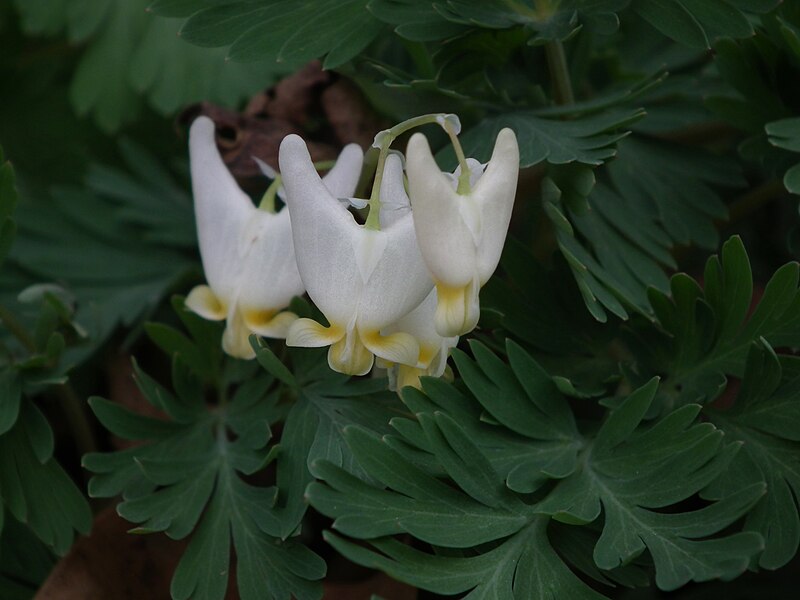
Just coming out in Bird Park, Mount Lebanon. For a description, see the Dicentra cucullaria reference page.

Just coming out in Bird Park, Mount Lebanon. For a description, see the Dicentra cucullaria reference page.

Just beginning to bloom in Bird Park, Mount Lebanon. For a complete description, see the article on Dicentra cucullaria on the Flora Pittsburghensis reference site.





Squirrel Corn is easily confused with Dutchman’s Breeches (Dicentra cucullaria), but the shape of the flowers is an infallible marker. These are shaped like the common Bleeding-Hearts of our gardens; they lack the pointed lobes that make Dutchman’s Breeches look like a pair of pantaloons hung out to dry. These were blooming in Fox Chapel near the Trillium Trail at the beginning of May.


Gray describes the genus and the species:
DICÉNTRA Berah. Petals slightly cohering into a heart-shaped or 2-spurred corolla, either deciduous or withering-persistent. Stigma 2-crested and sometimes 2-horned. Filaments slightly united into two sets. Pod 10-20-seeded. Seeds crested. — Low stemless perennials (as to our wild species) with ternately compound and dissected leaves, and racemose nodding flowers. Pedicels 2-bracted. (Name from dis, twice, and kentron, a spur; — accidentally printed Diclytra in the first instance, which by an erroneous conjecture was changed afterwards into Dielytra.) Bikukulla Adams. Bicuculla Millsp.
Raceme simple, few-flowered.
D. canadensis (Goldie) Walp. (SQUIRREL CORN.) Subterranean shoots bearing scattered grain-tike tubers (resembling peas or grains of Indian corn, yellow); leaves as in no. 1 [Dutchman’s Breeches, D. cucullaria]; corolla merely heart-shaped, the spurs very short and rounded; crest of the inner petals conspicuous, projecting. (Bicuculla Millsp.) — Rich woods, N. S. to Ont. and Minn., s. to Va., Ky., and Mo. Apr., May. — Flowers greenish white tinged with rose, with the fragrance of hyacinths.

More pictures of this bright yellow woodland poppy, which was blooming in great profusion at the south end of the Trillium Trail in Fox Chapel.

We repeat our earlier article on this species:
Like a larger version of the Celandine, this bright yellow poppy blooms at the same time, but is easily distinguished by its larger flowers with overlapping petals and bright orange stamens. These plants were blooming at the beginning of May along the Trillium Trail in Fox Chapel.
Gray describes the genus and the species:
STYLOPHORUM Nutt. CELANDINE POPPY. Sepals 2, hairy. Petals 4. Style distinct, columnar; stigma 2-4-lobed. Pods bristly, 2-4-valved to the base. Seeds conspicuously crested. — Perennial low herbs, with stems naked below and oppositely 2-leaved, or sometimes 1-3-leaved, and umbellately 1-few-flowered at the summit; the flower-buds and the pods nodding. Leaves pinnately parted or divided. Juice yellow. (Fromstylos, style, and pherein, to bear, one of the distinctive characters.)
S. diphyllum (Michx.) Nutt. Leaves pale beneath, smoothish, deeply pinnatifid into бог 7 oblong sinuate-lobed divisions, and the root-leaves often with a pair of small distinct leaflets; peduncles equaling the petioles; flower deep yellow (5 cm. broad); stigmas 3 or 4; pod ovoid. —Damp woods, w. Pa. to Wisc., “Mo.,” and Tenn. May. —Foliage and flower resembling Celandine.
Like a larger version of the Celandine, this bright yellow poppy blooms at the same time, but is easily distinguished by its larger flowers with overlapping petals andbright orange stamens. These plants were blooming at the beginning of May along the Trillium Trail in Fox Chapel.
Gray describes the genus and the species:
STYLOPHORUM Nutt. CELANDINE POPPY. Sepals 2, hairy. Petals 4. Style distinct, columnar; stigma 2-4-lobed. Pods bristly, 2-4-valved to the base. Seeds conspicuously crested. — Perennial low herbs, with stems naked below and oppositely 2-leaved, or sometimes 1-3-leaved, and umbellately 1-few-flowered at the summit; the flower-buds and the pods nodding. Leaves pinnately parted or divided. Juice yellow. (Fromstylos, style, and pherein, to bear, one of the distinctive characters.)
S. diphyllum (Michx.) Nutt. Leaves pale beneath, smoothish, deeply pinnatifid into бог 7 oblong sinuate-lobed divisions, and the root-leaves often with a pair of small distinct leaflets; peduncles equaling the petioles; flower deep yellow (5 cm. broad); stigmas 3 or 4; pod ovoid. —Damp woods, w. Pa. to Wisc., “Mo.,” and Tenn. May. —Foliage and flower resembling Celandine.